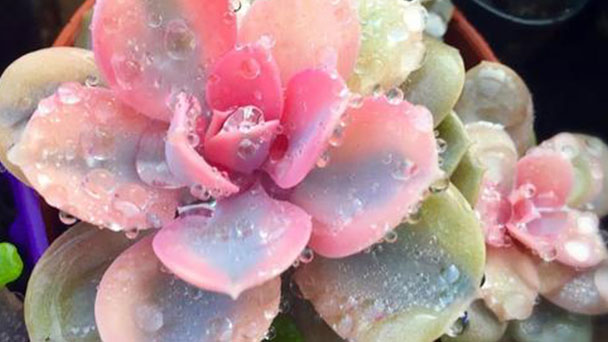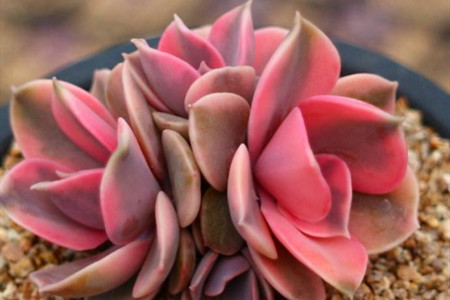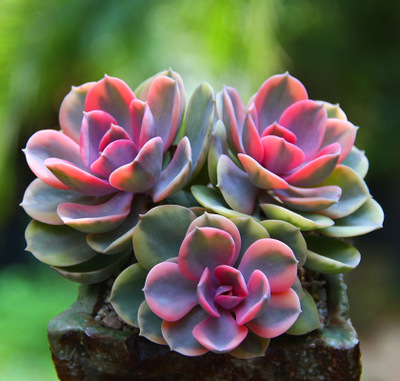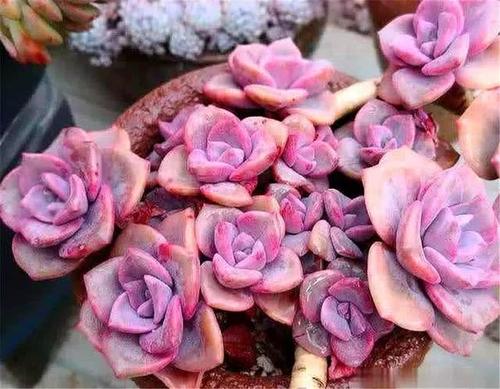How to Grow & Care for Echeveria Rainbow
Written by Maggie
Dec 28 2022

Echeveria Rainbow needs to be placed in the sun and carefully preserved to make its leaves more colorful and increase their ornamental value. In addition, it needs to keep the soil slightly wet. Don't water it frequently, just use the right amount of topdressing. It also needs to be turned over for soil conservation every year. When suffering from pests and diseases, it is necessary to spray corresponding insecticides for prevention and control.
All the information you require to take good care of your Echeveria rainbow is included in this article. Continue reading to learn more about this remarkable succulent.

What is Echeveria Rainbow?
The Echeveria rainbow is a succulent that belongs to the Crassulaceae family. The leaves of this plant are able to change color with the changes in season, and the leaves of the Echeveria rainbow are arranged in overlapping rosettes. These rosettes grow until they reach approximately six inches in diameter.
The edges of the older Echeveria rainbow leaves have a light pink color. The new leaves are characterized by green color at the center, while the edges have a pink color that is lighter than that of the older leaves. These mixed colors on the leaves of the The plant is referred to as Echeveria rainbow because of its name.
Echeveria Rainbow Quick Overview
The needs for this plant are listed in this practical table.
| Requirements | Echeveria Rainbow |
| Light | Full sunlight |
| Water | Water regularly during spring and summer, reduce watering in winter |
| Soil | Well-draining soils that are suitable for succulents |
| Temperature | Temperatures ranging from 65 to 70 degrees Fahrenheit |
| Fertilizer | Apply a controlled-release fertilizer at the beginning of the plant's growing season |
How to Care for Echeveria Rainbow
Get Plenty of Light for Echeveria Rainbow
Echeveria Rainbow is a plant that loves the sun. Usually in the process of farming, whether outdoors or indoors, it needs to be placed in the sun. Only with the help of sunlight can the leaves appear pink and purple, increasing the ornamental value of the plant. But we need shade to conserve in summer.
Water and Fertilizer Management
Echeveria Rainbow is actually very drought-tolerant. Do not give it frequent watering when breeding at ordinary times. In the summer we can increase the watering. Although its nutrient requirements are not high, if it is fertilized during growth, poor plant growth can be avoided.
During the spring and summer, when the Echeveria rainbow is growing, you should water it frequently. The growth rate of the rainbow succulent reduces in winter so you should reduce your watering frequency. This minimizes disruption as your plant enters its dormant stage.
The soil ought to be moist but never drenched after each watering. Waterlogged and soggy soils make your plant more susceptible to attack by fungal infections.
Water your plant thoroughly, allowing the extra water to run through the pot's drainage holes. Prior to providing additional water to the plant, allow the topsoil to become dry.
There is no harm in fertilizing your Echeveria rainbow in an effort to promote growth. The fertilizer should be applied as soon as the plant's growing season starts, but make sure to use a controlled-release fertilizer. You can even add a weak liquid solution of the fertilizer to your plant after every week.
Dilute a 20-20-20 fertilizer to quarter strength if your plant is mature. Utilize fertilizers with a low nitrogen content if they are still young. Remember not to fertilize your plant during the winter because high nitrogen fertilizers can burn your plant.

Change the Soil for Echeveria Rainbow
Usually, in Echeveria Rainbow's approach, if you want a plant to grow well, you have to turn the pot and replace the soil once a year. Peat soil, perlite, gravel, ashes and other materials can be used as a matrix, so as to promote the plant in the soil, continuous growth of the pot.
Temperature
These plants love desert conditions, so temperatures between 65 F and 70 F are conducive for the growth of the Your plant, the Echeveria rainbow, can endure temperatures as low as 50 F during the winter. The Echeveria rainbow is better grown among your houseplants because it does not tolerate temperatures below 50 F.
The color of the rainbow leaves of the Echeveria are influenced by temperature changes. The plant adopts lighter colors when temperatures are high and hot. When temperatures are lower, it is easy to see darker and denser colors.
Disease and Insect Control for Echeveria Rainbow
Echeveria Rainbow Rainbow is also vulnerable to pests and diseases during the spring and summer season, making its plants gradually lose life. Parts of the disease need to be treated immediately and then given a better growth environment. And we need to spray its corresponding insecticide, so that the plant is gradually restored to life.

How to Repot Echeveria Rainbow?
There are no rules about when to water your Echeveria rainbow. However, whenever you decide to repot your plant, do so during the warm season.
To start the repotting process, let the potting soil dry. Shake the soil off your plant after it has been uprooted gently. Examine your plant's roots, and cut out any that are rotten or damaged. If there are any cuts, treat them using a fungicide.
Prepare a pot with enough drainage holes. Spread the roots of your plants as you place your Echeveria rainbow in the pot and gradually add potting soil. After leaving your plant for about a week, lightly water it to avoid waterlogging.
Echeveria Rainbow Propagation
You can use seeds, leaf cuttings or offsets to propagate Echeveria rainbow. The propagation procedures work best in the spring.
Leaf Cuttings
The Echeveria rainbow is a hybrid plant. In order to preserve the mother plant's characteristics, leaf cuttings are the most effective method of propagation.
Get a healthy leaf-cutting by cutting it as close as you can to the stem of the mother plant. Put the plant on a flat surface and allow it to dry and form a callus — this might take a few days. Before planting a cutting in a well-draining potting mix, preferably one that contains sand, pumice, and soil, dip the cut end of the cutting into a rooting hormone. A commercially available cacti mix will also do well for your plant.
Keep the planted Echeveria rainbow cutting sunder temperatures around 50 F. Cover the dish in which you are propagating your plant until new leaves begin to sprout. To improve your chances of success, deal with two or more cuts.
Seeds
Growing Echeveria rainbow from seed is possible but it is a lengthy process. Simply buy commercially available Echeveria rainbow seeds and plant them in a well-draining potting mix. Water them sparingly until they start to sprout, then give them time to grow strong roots. After that, you can repot the young plants and tend to them just like you would any other rainbow succulent.
Problems of Echeveria Rainbow
The Echeveria rainbow is unlikely to be affected by pests and diseases if you take proper care of it. Be sure to remove dead leaves from the plant on a regular basis as leaving them on your plant will attract pests and diseases. Let's examine a few of the pests and diseases you should watch out for as you care for your plant.
Mealybugs
Mealybugs can be sneaky so you should check your plant for their presence on a regular basis. The simplest method would be to make sure you check your plant after each watering by inspecting the undersides of its leaves. If you notice some white cottony patches stuck to the leaves of your Echeveria rainbow, you have a mealybug infestation on your hands.
Mealybugs survive by sucking the sap of your Echeveria rainbow. This is why their extended presence and larger infestations can then lead to droopy leaves, whose vitality would have been drawn. Strong streams of water can be used to more effectively combat mealybug infestations that are less severe. For this, a garden hose can be used.
Use cotton balls that are dipped in 70 percent alcohol to dab the mealybugs if they are still in lower numbers, and you can directly spray the plant with alcohol if the infestation is high. Neem oil blocks the breathing holes on the surface of the mealybugs, thereby killing them. If you don't have access to Neem oil, you can substitute insecticidal soap.
Fungus
The Echeveria rainbow can be easily attacked by fungal infections. When you overwater your plant, which causes root rot, this likelihood increases. Also, avoid watering the Echeveria rainbow from the top of its leaves because water might sit on the plant's rosettes, which may also cause leaf rot.
Fungal infections are common in Echeveria seedlings when they are less than two weeks old. The seedlings must therefore be lightly watered in order to safeguard them from fungus infections. When you detect a fungal attack on your Echeveria rainbow, treat it with fungicides.
If the damage by the fungal attack is severe by the time you notice it, remove healthy parts of the plant and propagate them. If the plant can't be salvaged, then there's nothing to do but to incinerate it. To prevent the fungal infection from spreading to other plants, don't forget to clean the area where the afflicted plant was placed.
Where to Plant Echeveria Rainbow
Succulents like the Echeveria Rainbow need a lot of light. Make sure it receives sunlight when you plant this variety of succulent in a garden. For its growth, full to partial sun is best. It is preferable to grow outdoors as opposed to indoors.
This particular variety of succulent prefers a warm environment. It can survive at zone 9a-11b which is around -6.7°If you live in a cold climate, it is best to grow Rainbow indoors at 20°C (68°F). The plant will grow happily as long as it receives enough sunlight.
Conclusion: Echeveria Rainbow Care
One of the most beautiful succulent plants is the Echeveria Rainbow, which is friendly and low-maintenance. It can be grown with ease if you give it enough water and bright, direct sunlight. In addition, its nontoxic nature and ability to purify the air make it a worthwhile option for plant lovers.
Latest Updated
- Benefits of Bugleweed - 7 Science-backed Health Benefits
- Bugleweed Dangers & Side Effects - Is It Poisonous?
- How to Plant Evergreen Trees - What You Should Know
- When to Plant Evergreens - Grow Guide for Evergreen Trees
- 12 Wonderful Evergreen Shrubs for Your Garden
- 12 Popular Evergreen Plants with Pictures for Beginners
- When And How To Prune A Lilac Bush Like a Pro
- How to Grow & Care for Lilac Vine (Hardenbergia Violacea)
- Japanese Lilac Tree (Syringa Reticulata) Care & Propagation Guide
- Shumard Oak Pros and Cons - What to Know
Popular Articles
- Winter maintenance of Antirrhinum Majus
- How to Grow Terminalia Mantaly Tree
- How to Grow and Care for Crossostephium Chinense
- How to grow Antirrhinum Majus in spring
- Peristeria Elata (Dove Orchid) Profile: Info & Care Guide
- Underwatered Snake Plant (Sansevieria Trifasciata) - Signs And How To Fix
- How to Care for Brazilian Jasmine Plant (Mandevilla Sanderi)
- How to Grow & Care for Graptopetalum Purple Delight in Summer
- Rosa Chinensis (China Rose): Plant Growing & Care Tips
- How to Care for Baby Sun Rose (Aptenia Cordifolia)